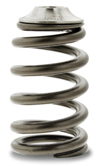Using a small valve spring on a highly boosted four-cylinder engine
 Containing a valvetrain that works with a four-cylinder, heavily boosted engine that develops more than 1000 hp should be a difficult enterprise, but Time Attack factory Scion (Toyota) team WORLD Racing is having no problems with its steel coil valve springs.
Containing a valvetrain that works with a four-cylinder, heavily boosted engine that develops more than 1000 hp should be a difficult enterprise, but Time Attack factory Scion (Toyota) team WORLD Racing is having no problems with its steel coil valve springs.
Time Attack, which is a form of American road racing where the car-driver tandem compete for a time slip is "a bit of road racing with a bit of a drag racing element to it," according to Rob Cardona, WORLD Racing's manager.
WORLD Racing competes in the unlimited category using a 2AXFE 2.4 litre all-aluminium engine with a single turbocharger in its Scion tC. "Right now we're running about 1000 horsepower and maybe a little bit more; we can run up to 50 pounds of boost, depending on the atmosphere and the racetrack," said engine builder Gary Kubo.
Because the team designs its engine to run at a moderate rpm range, typically not exceeding 7800 rpm, Kubo ends up with a broad power band where, he said, "The sweet spot is between 4700 and 5700 rpm, and on some tracks with long straightaways we actually get to 7800. This way there's less cycles on the valve springs and obviously less rpm and less torture to the valvetrain."
Incredibly, the team is running a single beehive spring on its engine at 110 lb of pressure installed. "We're probably going to have to up that as we go up on the boost," Kubo said.
It might seem impossible to believe, but the team has used simple inspection procedures on its valve springs over the past few years. "We just check them and they've maintained the same pressure for the last three years," Kubo said.
The team has been using the same valve spring spec - equal for both intake and exhaust - for those three years. "Before that, we used OEM springs, which were good for about 700 horsepower. But because we didn't want to bust a retainer in half or something like that, we changed. We didn't want to take a chance because the boost pressure kept going up," he said.
At that time the team was running gasoline but it has since changed to methanol as its fuel of choice. "We decided to be safe and go along with the titanium retainer and a billet keeper," said Kubo. "This spring is made of a proprietary material from the manufacturer but they still manage to keep their pressure - even with the high temperatures coming with all our boost [of up to 50 psi]."
The rationale Kubo gives is that the rpm level is so low. "If the revs were higher we'd need a double spring to resonate the harmonics, but we've had no harmonics problems. We've never broken a valve spring, never dropped a valve, never lost a keeper, nothing."
Every time the engine is serviced, which is in the neighborhood of 30 hours, the team looks at the springs. "If we push an engine hard, that's about six races, and whether it's good or not, we're going to take it apart and check all components."
Kubo expects that the team will eventually be forced to go to a double spring. "But we haven't found the necessity yet, so why spend the extra money? That would be based on rpm and boost because, when you start running a lot of boost, the pressure wants to pop the intake valve open before the cam opens it, so you need seat pressure to hold the valve shut.
"That," he confirms, "is our biggest problem. On the exhaust side, mainly it's the closing of the exhaust valve that's critical because you want to make sure it shuts and cuts all the heat from the exhaust."
Still, most of the development work at WORLD Racing is based on the single spring; the team hasn't delved into 500-width cams. "That's because we'd have to build a 10,000 rpm engine, and that's more money," said Kubo. "We've found our sweet spot under 8000 rpm and that's more impressive than having an expensive engine where we'd have to replace the valve springs every session. That's nothing to brag about - it works so let's leave it!"
Fig. 1 - Beehive valve spring for the 2AZFE engine (Courtesy of Ferrea)
Written by Anne Proffit